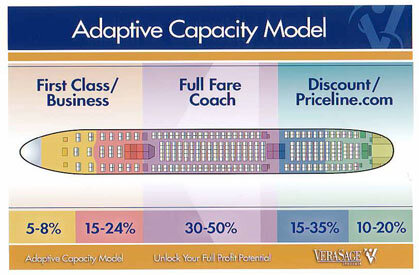The Airplane Metaphor
I've been having an e-mail discussion with Bob Harper, of More Software in the UK, during this past week over an article he wrote about the airplane analogy we use here at VeraSage.Officially, it's known as the Adaptive Capacity Model, which I used originally in The Firm of the Future to illustrate Baker's Law: Bad customers drive out good customers.A copy of the airplane diagram is one of the most frequent requests we get (see diagram below). It's an enormously powerful analogy. We actually recommend that firms slide it across the desk to each customer, at least once a year, and ask "Where would you like to sit in our airplane."The model has implications for strategy, customer selection, de-selection, allocating capacity to different customers, offering, communicating and capturing various levels of value depending on where the customer wants to sit, and even more. It's a powerful metaphor.We've even had discussions about the model's implications for project management (each project is a different plane, according to Ed Kless), team member leadership (each team member is an airplane, ala Dan Morris). You can see the endless ways you can expand this analogy.But I'm a firm believer in Occam's Razor--don't unnecessarily complicate the theory. The reason the airline diagram is powerful is because almost everyone has flown. They know they have a choice of how much to pay and where to sit. They understand different customers get different levels of service and pay radically different prices, even for the same flight. But it's not the same flight!As a 1K flier on United, I recently flew to Spain on business. For me, that flight was vital, for if I didn't arrive on time, the loss of goodwill would be incalculable. But for the leisure traveler, they're not as time sensitive. Huge difference in value, even though it doesn't cost United any more to fly me than him.Also, people understand they may get bumped—actually, bribed with a free flight—from a flight to accommodate a 1K flier, or even sometimes a 1K flier gets bumped to accommodate an even more valuable flier, say a One Million Mile flier.There are many implications, but I want people to read into the model what is important to them. For one firm leader, they may have too many people in the back of the plane, so it may inspire them to shed customers and free up some capacity. For others, the message may be they have to do a better job differentiating customers based on various levels of value.Here is what I wrote to Bob after a few emails that I thought were getting too complex:
Bob,You can see how easy it is to take this metaphor of a plane to extreme levels. Some of our VS Fellows think that each team member in the firm represents a different plane, with it's own capacity, competency level. We can take this analogy too far.Bottom line is this: Any firm can only handle so many customers, given its existing size. What we refer to as the firm's Theoretical Capacity.
- How many customers do they want in each class? This is the firm's Optimal Capacity, which is probably 60-70% of its Theoretical Capacity.
- How much capacity should they reserve for their best customers and team member down time?
- When should they stop adding capacity for back-of-the plane customers?
- What is the value proposition for each section of the plane?
And here's the biggest question of all: Where does the customer want to sit?The firm DOES NOT decide this, the customer does. How? Ask them. We have firms who slide the picture of the plane over to the customer and ask, "Where would you like to sit in our plane." This forces the firm to communicate the value proposition for each section of the plane, just like the airlines have (quite effectively I might add).Keep it simple with this. I know from experience how we can add many layers of complexity that don't mean a whole lot. People will draw their own conclusions from the metaphor, that's the beauty of thinking for one's self.Ron
I'd love to know what the Airplane diagram meant to you when you first saw it, and how it has changed how your firm views it value proposition, pricing, customer selection, etc.As Aristotle said: "But the greatest thing by far is to be a master of metaphor. It is one thing that cannot be learnt from others; and it is also a sign of genius, since a good metaphor implies an intuitive perception of the similarity between dissimilars."
